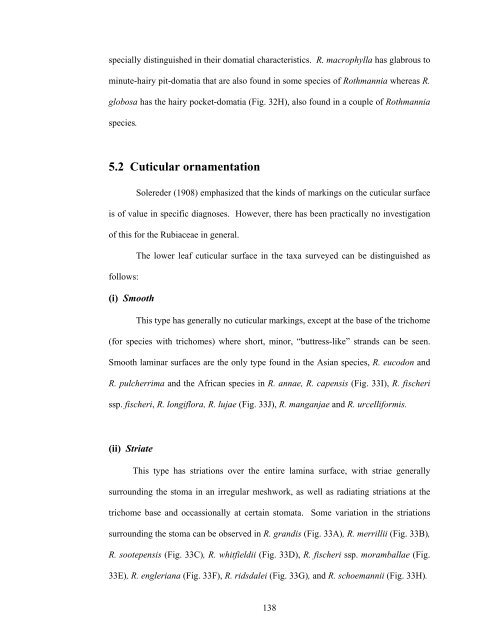Chapter 5.pdf - DSpace@UM
Chapter 5.pdf - DSpace@UM
Chapter 5.pdf - DSpace@UM
You also want an ePaper? Increase the reach of your titles
YUMPU automatically turns print PDFs into web optimized ePapers that Google loves.
specially distinguished in their domatial characteristics. R. macrophylla has glabrous tominute-hairy pit-domatia that are also found in some species of Rothmannia whereas R.globosa has the hairy pocket-domatia (Fig. 32H), also found in a couple of Rothmanniaspecies.5.2 Cuticular ornamentationSolereder (1908) emphasized that the kinds of markings on the cuticular surfaceis of value in specific diagnoses. However, there has been practically no investigationof this for the Rubiaceae in general.The lower leaf cuticular surface in the taxa surveyed can be distinguished asfollows:(i) SmoothThis type has generally no cuticular markings, except at the base of the trichome(for species with trichomes) where short, minor, “buttress-like” strands can be seen.Smooth laminar surfaces are the only type found in the Asian species, R. eucodon andR. pulcherrima and the African species in R. annae, R. capensis (Fig. 33I), R. fischerissp. fischeri, R. longiflora, R. lujae (Fig. 33J), R. manganjae and R. urcelliformis.(ii) StriateThis type has striations over the entire lamina surface, with striae generallysurrounding the stoma in an irregular meshwork, as well as radiating striations at thetrichome base and occassionally at certain stomata. Some variation in the striationssurrounding the stoma can be observed in R. grandis (Fig. 33A), R. merrillii (Fig. 33B),R. sootepensis (Fig. 33C), R. whitfieldii (Fig. 33D), R. fischeri ssp. moramballae (Fig.33E), R. engleriana (Fig. 33F), R. ridsdalei (Fig. 33G), and R. schoemannii (Fig. 33H).138
















